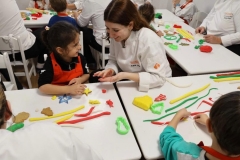
SCHOOL OF APPLIED MANAGEMENT SCIENCES
Gastronomy and Culinary Arts Program
GEAR 306 | Course Introduction and Application Information
| Course Name |
Hollywood Cinema
|
|
Code
|
Semester
|
Theory
(hour/week) |
Application/Lab
(hour/week) |
Local Credits
|
ECTS
|
|
GEAR 306
|
Fall/Spring
|
3
|
0
|
3
|
4
|
| Prerequisites |
None
|
|||||
| Course Language |
English
|
|||||
| Course Type |
Service Course
|
|||||
| Course Level |
First Cycle
|
|||||
| Mode of Delivery | - | |||||
| Teaching Methods and Techniques of the Course | DiscussionQ&ALecture / Presentation | |||||
| Course Coordinator | - | |||||
| Course Lecturer(s) | ||||||
| Assistant(s) | - | |||||
| Course Objectives | This course aims to enable students to develop a general knowledge of Hollywood's production/distribution/exhibition networks. It identifies main themes and styles throughout Hollywood's history and discusses its patterns of authorship, star system, technology and genres. The course contextualizes Hollywood as a global system not only as a business but also as a system of meanings. |
| Learning Outcomes |
The students who succeeded in this course;
|
| Course Description | This course examines Hollywood in its economic, cultural and historical context. It studies its industrial dynamics (studio system, star system, etc.) in parallel with its narrative tendencies and stylistic devices. Students are expected to attend the lectures, watch the films and actively participate with the class discussion following each screening. |
|
|
Core Courses | |
| Major Area Courses | ||
| Supportive Courses | ||
| Media and Management Skills Courses | ||
| Transferable Skill Courses |
WEEKLY SUBJECTS AND RELATED PREPARATION STUDIES
| Week | Subjects | Related Preparation |
| 1 | Review of the Semester | |
| 2 | Review of the Semester | |
| 3 | Introduction - Hollywood and Social Change Modern Times (1936) Charlie Chaplim | Howe, Lawrence. "Charlie Chaplin in the age of Mechanical Reproduction: reflexive ambiguity in Modern Times." College Literature 40, no. 1 (2013): 45-65. |
| 4 | There is No Place Like Home The Wizard of Oz (1939) Victor Fleming | Pawlett W., Dhanda M., (2010) "The Shared Destiny of the Radically Other: A reading of The Wizard of Oz". Film-Philosophy, Paige, L.R. (1996) Wearing the Red Shoes: Dorothy and the Power of the Female Imagination in The Wizard of Oz, Journal of Popular Film and Television, 23:4, 146-153, |
| 5 | Doing the Thinking for U.S. Casablanca (1942) Michael Curtiz | Nachbar, Jack, (2000) "Doing the Thinking for All of Us: Casablanca and the Home Front", Journal of Popular Film and Television, 27:4, 5-15, |
| 6 | Modern Horror Pscycho (1960) Alfred Hitchcock | Clover, Carol J. “Her Body, Himself: Gender in the Slasher Film.” Representations, no. 20, 1987, pp. 187–228. JSTOR, https://doi.org/10.2307/2928507. |
| 7 | New Hollywood Bonnie and Clyde (1967) Arthur Penn | King, G. (2002). New Hollywood Cinema: An Introduction. Bloomsbury Publishing, pp. 1-39. Schatz, T. The New Hollywood (PDF handout). Tzioumakis, Y. (2006). The New Hollywood and the Independent Hollywood in American Independent Cinema: An Introduction (Rutgers, pp. 169-191. |
| 8 | Midterm Exam | |
| 9 | Misogyny and the Threat to Masculinity One Flew Over the Cuckoo’s Nest (1975) Milos Forman | Farber, S., Americana, Sweet and Sour, The Hudson Review, Vol. 29, No. 1 (Spring, 1976), pp. 95-102 |
| 10 | Independent Cinema Do The Right Thing (1989) Spike Lee | Lott, T. L., A No-Theory Theory of Contemporary Black Cinema. Black American Literature Forum, Vol. 25, No. 2, Black Film Issue (Summer, 1991), pp. 221-236. |
| 11 | The Myth of Boyhood Rushmore (1998) Wes Anderson | Olsen, Mark. “If I Can Dream: The Everlasting Boyhoods of Wes Anderson.” Film Comment, vol. 35, no. 1, 1999, pp. 12–17. |
| 12 | History and Politics in Horror Cinema Get Out (2017) Jordan Peele | Landsberg, Alison, (2018) Horror Vérité: Politics and History in Jordan Peele’s Get Out. Continuum, 32:5, pp. 629-642. |
| 13 | Modern Nomads Nomadland (2020) Chloé Zhao | Lindemann, Tim. “Travelling the Scenic Landscape: Community, Nationalism and Precarity in Nomadland.” Empedocles: European Journal for the Philosophy of Communication, Volume 13, Number 1, 1 June 2022, pp. 25-40. White, Patricia. “Women Auteurs, Western Promises” Film Quarterly (2022) 75 (4): pp. 23–33. |
| 14 | Course Review/Final Exam | |
| 15 | Course Review | |
| 16 | Course Review |
| Course Notes/Textbooks | |
| Suggested Readings/Materials | Bordwell, David, and Kristin Thompson. Film History: An Introduction. New York: McGraw-Hill, 2008 |
EVALUATION SYSTEM
| Semester Activities | Number | Weigthing |
| Participation |
1
|
10
|
| Laboratory / Application | ||
| Field Work | ||
| Quizzes / Studio Critiques | ||
| Portfolio | ||
| Homework / Assignments | ||
| Presentation / Jury | ||
| Project | ||
| Seminar / Workshop | ||
| Oral Exams | ||
| Midterm |
1
|
40
|
| Final Exam |
1
|
50
|
| Total |
| Weighting of Semester Activities on the Final Grade |
3
|
100
|
| Weighting of End-of-Semester Activities on the Final Grade | ||
| Total |
ECTS / WORKLOAD TABLE
| Semester Activities | Number | Duration (Hours) | Workload |
|---|---|---|---|
| Theoretical Course Hours (Including exam week: 16 x total hours) |
16
|
3
|
48
|
| Laboratory / Application Hours (Including exam week: '.16.' x total hours) |
16
|
0
|
|
| Study Hours Out of Class |
0
|
||
| Field Work |
0
|
||
| Quizzes / Studio Critiques |
34
|
0
|
|
| Portfolio |
0
|
||
| Homework / Assignments |
0
|
||
| Presentation / Jury |
0
|
||
| Project |
0
|
||
| Seminar / Workshop |
0
|
||
| Oral Exam |
0
|
||
| Midterms |
1
|
30
|
30
|
| Final Exam |
1
|
42
|
42
|
| Total |
120
|
COURSE LEARNING OUTCOMES AND PROGRAM QUALIFICATIONS RELATIONSHIP
|
#
|
Program Competencies/Outcomes |
* Contribution Level
|
||||
|
1
|
2
|
3
|
4
|
5
|
||
| 1 | Successfully applies theoretical and practical knowledge and skills in Gastronomy and Culinary Arts |
|||||
| 2 | Carries best practices in terms of work and food security, safety and hygiene in food production |
|||||
| 3 | Appreciates, evaluates and makes decisions regarding to visual, textual and nutritional data with respect to food production and presentation |
|||||
| 4 | Recognizes and evaluates the impact of gastronomy on culture and society |
|||||
| 5 | Assumes responsibility for solving complex problems that may occur in the field of Gastronomy and Culinary Arts, both individually and as a team member |
|||||
| 6 | Evaluates the knowledge and skills acquired in the field of Gastronomy and Culinary Arts with a critical approach and effectively communicate their ideas and suggestions for solutions in written and oral form. |
|||||
| 7 | Possesses necessary knowledge and skills in relevant fields such as gastronomy, design, law and management and effectively apply them to the practice of Culinary Arts |
|||||
| 8 | Uses the technological tools related to Gastronomy and Culinary Arts effectively |
|||||
| 9 | Updates and improve the knowledge, skills and competencies related to Gastronomy and Culinary Arts with lifelong learning awareness and sustainability with an ethical approach |
|||||
| 10 | Collects data in the areas of Gastronomy and Culinary Arts and communicate with colleagues in a foreign language. (European Language Portfolio Global Scale”, Level B1) |
|||||
| 11 | Speaks a second foreign at a medium level of fluency efficiently |
|||||
| 12 | Relates the knowledge gained through the history of humanity to the field of expertise |
|||||
*1 Lowest, 2 Low, 3 Average, 4 High, 5 Highest
NEWS |ALL NEWS

Aegean flavors from the chefs of the future
Izmir University of Economics (IUE) Department of Gastronomy and Culinary Arts left its mark on the 6th Izmir GastroFest, organized this year with
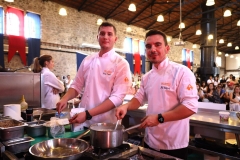
They added flavor to GURMEFEST
GURMEFEST, one of the biggest food, drink and entertainment festivals of Izmir, was ‘flavored’ with the dishes prepared and presented by the
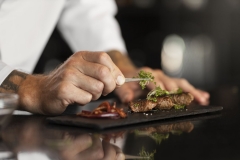
“Izmir and Bodrum will class up”
The MICHELIN Guide, one of the most prestigious restaurant rating systems in the world, has added Izmir and Bodrum to its Turkish
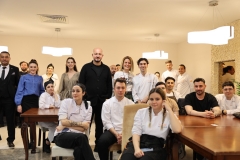
IUE graduates will prepare the flavors unique to Turkish cuisine
Bilsev Group, who is preparing to expand to Dubai this year with its Ferdi Baba, Fabrice Restaurant and Baba Pizza brands, will
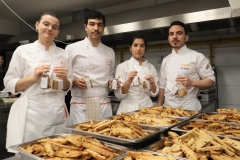
They prepared products that are filling and have a long shelf life
25 students of Department of Gastronomy and Culinary Arts of Izmir University of Economics (IUE) prepared products with a long shelf life,




